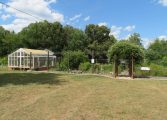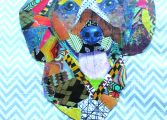By Page H. Gifford
Correspondent
Lake Monticello residents Al and Sue Mink just returned from their latest three-month adventure in Ljubljana, the capital of Slovenia. The Minks take two trips a year abroad, living in various areas and “nesting” for three months. The places they travel to are not ones that most travelers would gravitate to but certainly worth the trip.
Slovenia, equal to the size of Virginia, is surrounded by Italy, Austria, Hungary, and Croatia. Ljubljana, where the Minks stayed, is about 63 square miles, and the population is about 20 percent more than that of Charlottesville.
“Slovenia has had a challenged history – struggling for self-identity and independence. In 1278, it became part of the Hapsburg Empire and remained so until the breakup of the Empire just before WWI, except for a brief interlude from 1809-1813 when Napoleon ruled the area,” said Sue. “Ljubljana’s Austrian name was Leibach, and it’s still called Leibach in the German language. After a very unstable political time after WWI, it eventually became part of Yugoslavia and was under the rule of Tito, a socialist dictator. In 1991, Slovenia broke off from Yugoslavia to form its own democratic country and made Ljubljana the capital.”
Ljubljana is a picturesque Alpine city, including a large castle on the hill in the center of town. Sue said that Ljubljana was blessed with a gifted urban architect, Joze Plecnik, who redesigned much of the city in the early 1900s after a major earthquake, in a delightful blend of classical and Art Nouveau styles, with a strong emphasis on making the city livable.
“Unlike most European cities, Ljubljana did not suffer massive destruction during WW II. A large portion of the downtown is a pedestrian zone, with a river running through the center and beautiful walkways with cafes and willow trees lining the banks.”
Slovenia’s culture is very Austrian, with influences of Italy on the western side of the country. The topography is mountainous, with caves throughout the region.
“It’s an undiscovered gem that is refreshingly free of tourists except for the occasional tour group in Ljubljana and Lake Bled. Other than that, you can climb up to castles that might only have a school group, explore empty museums, and hike spectacular trails without seeing anyone but locals,” she said. “If you’d like to visit a beautiful place with much of the population speaking English, that has very few tourists, this is it.”
She describes the two most spectacular sights in Slovenia, other than Ljubljana, are Lake Bled and the caves in the Karst region.
“Lake Bled is one of the most beautiful places I’ve ever seen, ringed by the Alps, with a picturesque castle and a tiny island in the center with a medieval church. The two most famous caves in the Karst region, which is the area near Italy, are Postojna, the most touristy, with a little train you can ride to see the formations, and the stunningly spectacular Skocjan cave, which looks like something out of the Lord of the Rings.”
If you are a wine connoisseur, she says the Karst region makes some wonderful red wines, while the eastern part of the country, closer to Croatia, makes terrific white wines.
They also experienced another facet of Slovenia life that was unexpected when Al suffered a major injury. Three weeks before their planned return to Lake Monticello, Al fell from his bike on a very slippery turn in the road. A woman stopped and brought him to a medical clinic where they decided he needed x-rays and put him in an ambulance to bring him to a hospital in the city of Bezice, near the border with Croatia. Al alerted Sue who boarded a train to Brezice. On the train, Sue learned that Al had broken his femur and required emergency surgery. But, the hospital surgeon permitted her to see him later that first night.
“The medical care in the hospital was excellent. The staff was all very caring and competent and he got excellent PT. The downsides were that the facility itself was old and there were five people in a room. The food was also meager, while the quality was generally good, the portions were very small, and family members brought in food for their loved ones.” Sue said she learned to do that too. Visiting hours were only one hour each day. “The staff was kind and compassionate and we felt that he was getting the best care possible.”
He stayed in the hospital for five days to recover before they allowed him to go back to the apartment in Ljubljana. He could not fly home for another two weeks because of the danger of blood clotting and other post-surgery complications with an extended flight.
Instead, they began physical therapy to start Al on the road to recovery.
“We looked into the PT facilities and found that they were beautiful spas that also doubled as vacation resorts. We booked the facility for the last 12 days in Slovenia. It was a great decision.” He had three and a half hours a day of water, gait, electric, and basic physical therapy and she says he improved dramatically. “Despite the tragedy of the accident, we enjoyed a beautiful facility with great food, saunas, steam rooms, heated pools, and hot tubs,” she said. “We learned that with an injury like his, the Slovenian government paid for physical therapy for 14 days at private inpatient PT establishments. Of course, not being a Slovenian citizen, it wasn’t free for us. But still, the price for the resort was less than the cost of a hotel in a major U.S. city.”
Regarding the costs, they had to work with their USA insurance company, TRICARE, to file a claim. Medicare doesn’t cover overseas medical costs, not even for emergency medical help.
“Al worked with the hospital and asked them to submit their costs to our insurance so we wouldn’t have to file a claim ourselves afterward. In the process, we saw the medical costs – and were astounded at how much less Slovenia charged compared to hospitals in the USA.” Sue said the total cost for all care, the initial exam, a 40 minute ambulance ride, emergency surgery, five days in the hospital and ten days of physical therapy (of course room and board was additional.) was less than $4,800. “We have yet to know what our insurance will cover all of that. But, if we were Slovenian, their government would pay for it all.”
She adds that these services for Slovenians cost more through a higher tax rate, averaging about 27 percent of a citizen’s paycheck.
“There are a lot of fees for businesses and a lot of regulations and taxes for starting and running a business. Wages are generally lower than in Western Europe, while prices for food in grocery stores seem to be similar to those of Charlottesville. But all in all, Slovenians have a comfortable standard of living without the fears of a catastrophic bill for health care, with good child care, and cities that are clean, safe, and comfortable,” she said. “Things aren’t perfect in Slovenia, but it was interesting to see how other countries work when there’s a crisis. We’re really glad to be back in the States, but we’re grateful for the concern and care we were shown while dealing with this accident in a foreign country.”



